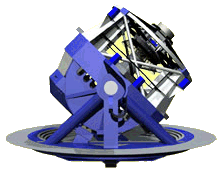 Associated Press reports that Google will help scientists "build a huge sky-scanning telescope" that will give people access to "digital footage of asteroids, supernovas and distant galaxies".
Associated Press reports that Google will help scientists "build a huge sky-scanning telescope" that will give people access to "digital footage of asteroids, supernovas and distant galaxies". The 8.4-meter LSST is expected to begin surveying the sky in 2013, from a mountaintop in Chile. Its goal is to continuously scan space, taking a series of 15-second exposures that allow it to cover the sky every three nights. Officials say the telescope will open "a movie-like window" on nearby asteroids and far-off exploding stars, and help explore the mysterious "dark energy" believed to fuel the universe's expansion.LSST Corporation shares more details about this collaboration:
LSST and Google share many of the same goals: organizing massive quantities of data and making it useful. Over 30 thousand gigabytes (30TB) of images will be generated every night during the decade-long LSST sky survey. The massive amount of data from LSST must be managed efficiently and analyzed in real time. Key areas in the Google-LSST collaboration will be: organizing the massive ingestion of information, processing and analyzing the continuous data streams in a 24/7 fault tolerant manner, enabling the new discoveries coming out of the LSST to be made available to the public and researchers in real time, and working with and managing large parallel data systems. In addition to aiding professional scientists and amateur astronomers, properly organized the LSST data will generate a new and dynamic view of the night sky for the public. LSST data will be valuable to curious minds of all ages, and will provide a powerful teaching tool.
Google also has an agreement with NASA that will allow it to show interesting data about our planet, moon and Mars in Google Earth. Hopefully, this telescope won't repeat Hubble's troubled history.
{ Image courtesy of LSST Corporation, where you can find out more about the project. }
Related:
Celestia - explore the universe

30 TB of image every night, that's a lot of pictures!
ReplyDelete